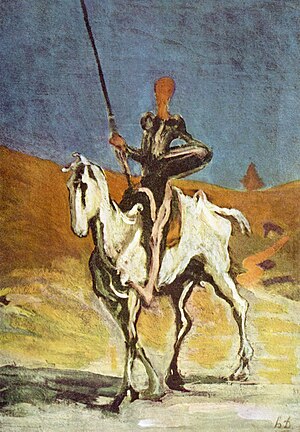Don Quixote (original version 1940-41, rev. 1947-49) (playlist)
Orquesta Sinfonica de Tenerife conducted by Victor Pablo Pérez
 |
| Don Quijote and Sancho Panza, drawn by Honoré Daumier, (Photo credit: Wikipedia) |
If the trumpet theme represents the man of flesh and blood, the abstractions which immediately follow represent the fantasy-world in which it becomes possible for Don Quixote to confuse his erstwhile love Aldonza Lorenzo - a peasant girl of easy virtue - with his courtly ideal, Dulcinea del Toboso. The cor anglais theme depicting his vision of Dulcinea serves to calm the "crazed" side of his imagination, and inspires him to set forth on his journey of knight errantry, accompanied by the faithful Sancho Panza. Burra's front cloth depicts them from behind, mounted on Rozinante and crossing the plain of la Mancha
~ David Drew (1982)
2. Dance of the Muleteers
At a wayside inn of dubious repute, muleteers are dancing with the wenches. Their revelry is interrupted by the arrival of Don Quixote, who mistakes the inn for a castle, the innkeeper for its castilian, and the wenches for Ladies in distress. He begs the innkeeper to dub him a Knight, and two wenches take him out to the courtyard to observe the traditional Vigil at Arms. During a second vision of Dulcinea, he is disturbed by a muleteer. Enraged, he challenges him to a duel, but is immediately set upon by the entire crowd from the inn.
To get rid of his unwelcome guest,
the innkeeper solemnly dubs him a Knight.
~David Drew (1982)
 |
| Stone statue of Dulcinea del Toboso (Don Quixote's idealization of Aldonza Lorenzo) sculpted by Federico Coullaut-Valera (1912–1989) from 1956 to 1957. 2.90 metres high. Detail of the monument to Cervantes (1925–30, 1956–57) at the Plaza de España ("Spain Square") in Madrid. (Photo credit: Wikipedia) |
3. The Golden Age
After his famous encounter with the windmills, and his subsequent duel with a passing barber whose shaving-bowl he mistakes for the legendary helmet of Mambrino, the Don is exhausted. Sancho and two shepherds lead him to a resting-place beneath a tree, where he describes to them the legendary Golden Age and evokes for them an Arcadian idyll. But before long his is awakened to the harsh realities of his own (and Gerhard's) age by the appearance of a gang of galley-slaves, escorted by three Cuadrilleros. With Sancho's help he fells the Cuadrilleros and frees the slaves - who reward them for their pains by robbing them both and leaving them for dead.
~David Drew (1982)
4. The Cave of Montesinos
A front cloth depicts Don Quixote's dream of the Cave of Montesinos. The Lady Belerma enters together with her retinue and processes sorrowfully around the sarcophagus of her lover, the Knight Durandarte. When Don Quixote is introduced by Mentesinos as a celebrated breaker of spells, the effigy of Durandarte points an accusing finger at him. The Don has barely recovered form the shock when his dream becomes a nightmare; Dulcinea appears in the sluttish form of Aldonza. Horrostruck, he awakes; his faith in himself and his knightly mission are beginning to crumble. Meanwhile, he is being pursued by the Cuadrilleros and will soon be behind bars.
~David Drew (1982)
5. Epilogue
The final scene - beginning with the 'alla marcia" "theme" of the "Knightly" variations - is a phantasmagoria in which there are no narrative elements apart from the appearance of Dulcinea. In at last recognizing that she is none other than Aldonza, the Don is cured from his "madness", and yet reminded of his own and mankind's utopian ideals. With the realisation that such ideals are no less indispensable for being ultimately unattainable the dying Quixote renounces his mission with quiet dignity, and bids his sorrowing Squire farewell.
~David Drew (1982)
 |
| Roberto Gerhard Don Quixote |
Discover











